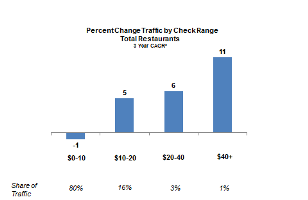 Income Gap and Shrinking Middle Class Take A Toll on Restaurant Industry, Reports NPD
Income Gap and Shrinking Middle Class Take A Toll on Restaurant Industry, Reports NPD
The gap between high- and low-income groups is the widest it has been in 100 years, and the share of U.S. consumers who identify with the middle class has never been lower. Like other retail sectors, the restaurant industry is feeling the effects of this cultural and economic phenomenon, reportsThe NPD Group, a leading global information company. One of the effects of income bifurcation is that visits to quick service restaurants, which have an average check size of about $5, were flat in the year ending June 2014 compared to same period last year, and visits to fine dining restaurants, which have an average check size of $40, were up 3 percent. Total restaurant industry traffic was flat for the period.
The challenge is that about 80 percent of restaurant visits are at quick service restaurants and the growth in fine dining visits, which holds only a single-digit traffic share, isn’t enough to increase overall traffic, according to NPD’sCRESTfoodservice market research. Low-income consumers, who are heavier users of quick service restaurants, were most adversely affected by the Great Recession and have less discretionary income to spend on dining out. With low-income visit cutbacks and not enough fine dining traffic to make-up for traffic declines, restaurant operators will need to appeal to the middle-class to fill the gap, says NPD.














